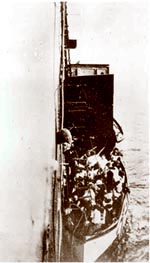The Rescue
Quoted ...
Boxhall: "She went down at about 2:30."
Rostron: "Were there many people left on board when she sank?"
Boxhall: "Hundreds and hundreds! Perhaps a thousand! Perhaps more! ... My God, sir, they've gone down with her. They couldn't live in this icy cold water."
Dialogue between Captain Rostron of the Carpathia and Fourth Officer Boxhall (April 15, 1912)
Shortly after 4.00 a.m., the first boat was picked up. Captain Rostron of the Carpathia was informed by Fourth Officer Boxhall of the fate of the Titanic. Now, as dawn came, the survivors could see that they were surrounded by icebergs, and some boats had to avoid several bergs while rowing towards the Carpathia. One boat after the other arrived at the Carpathia, though it was sometimes very difficult to get alongside, for some lifeboats were short of crewmen, and passengers had therefore to row or even to steer. At 8.10 a.m., the last lifeboat moved alongside. At 8.30 a.m., the last survivor was finally on board the Carpathia. The most dominant emotions among the survivors were joy, relief and gratitude. Therefore, two short services were held while cruising the area: One was a short prayer of thanksgiving for the 705 who had been rescued, and the other a funeral service for the more than 1500 people who had perished.
At 8.50 a.m., the Carpathia sailed away, proceeding to New York. This destination was considered best by Captain Rostron, as the route to Halifax would be certainly blocked by ice and the Mediterranean – the Carpathia's original destination – was too far away, as the provision would not last long enough.
The sympathy for the survivors among the passengers of the Carpathia was overwhelming: They donated clothes (some survivors left the Titanic in night dresses, others were only partly dressed), and many of them gave up their berths or took in people to fill spare ones. Nevertheless, the public rooms were filled with mattresses and blankets.
Meanwhile, hard work awaited the Carpathia's wireless operator: Personal messages from the survivors had to be transmitted to their loved ones. Later, the only surviving wireless operator of the Titanic, Harold Bride, volunteered to assist despite the fact that he suffered from frostbite and exposure. It was by wireless that the world now began to learn about the disaster.
